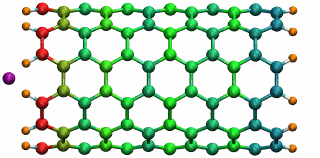_Part of the process (discharging) for electric nanotubes
When the liquid passes through coils of single-walled carbon nanotubes, an electric voltage is generated
Researcher and author: Dr. ( Afshin Rashid)

Note: When the liquid passes through coils of single-walled carbon nanotubes, an electric voltage is created. This technique is used to make liquid flow sensors to detect very small amounts of liquids and also to generate voltage in nano biosensors applications . Also, conductive nanotubes with high ionic strength produce more voltage .
Nanotubes have a very high surface density, which makes the nanotubes strong. It can be said that this property appears due to their remarkable smallness. Storage in nanotubes, every three carbon atoms have the ability to store one lithium ion, while in graphite, all six carbon atoms have the ability to store one lithium ion.
_ee5b.png)
Also, the ability to store energy in nanotubes is several times the volume of graphite electrodes. Therefore, a lot of hydrogen can be stored in nanotubes for energy applications and fuel cells. The increase in thermal power and resistance of nanotubes is proportional to the third root of the mass of atoms and molecules. Also, heating increases the strength of the nanotube and increases its tensile strength by six times, and its conductivity also increases.

The electric arc method is the most common and perhaps the simplest method to produce carbon nanotubes. However, this technique is a technique in which a mixture of nanotubes and impurities are produced, and it is necessary to separate nanotubes from soot, metals and catalysts in the raw product. In this method, nanotubes are produced through electric arc evaporation of two carbon rods that are opposite each other and approximately 1 mm apart. The heat caused by the discharge evaporates one of the carbon electrodes and a deposit in the form of small rods is obtained on the other electrode.
Conclusion :
When the liquid passes through coils of single-walled carbon nanotubes, an electric voltage is generated. This technique is used to make liquid flow sensors to detect very small amounts of liquids and also to generate voltage in nano biosensors applications . Also, conductive nanotubes with high ionic strength produce more voltage .
Researcher and author: Dr. ( Afshin Rashid)
Specialized doctorate in nano-microelectronics



